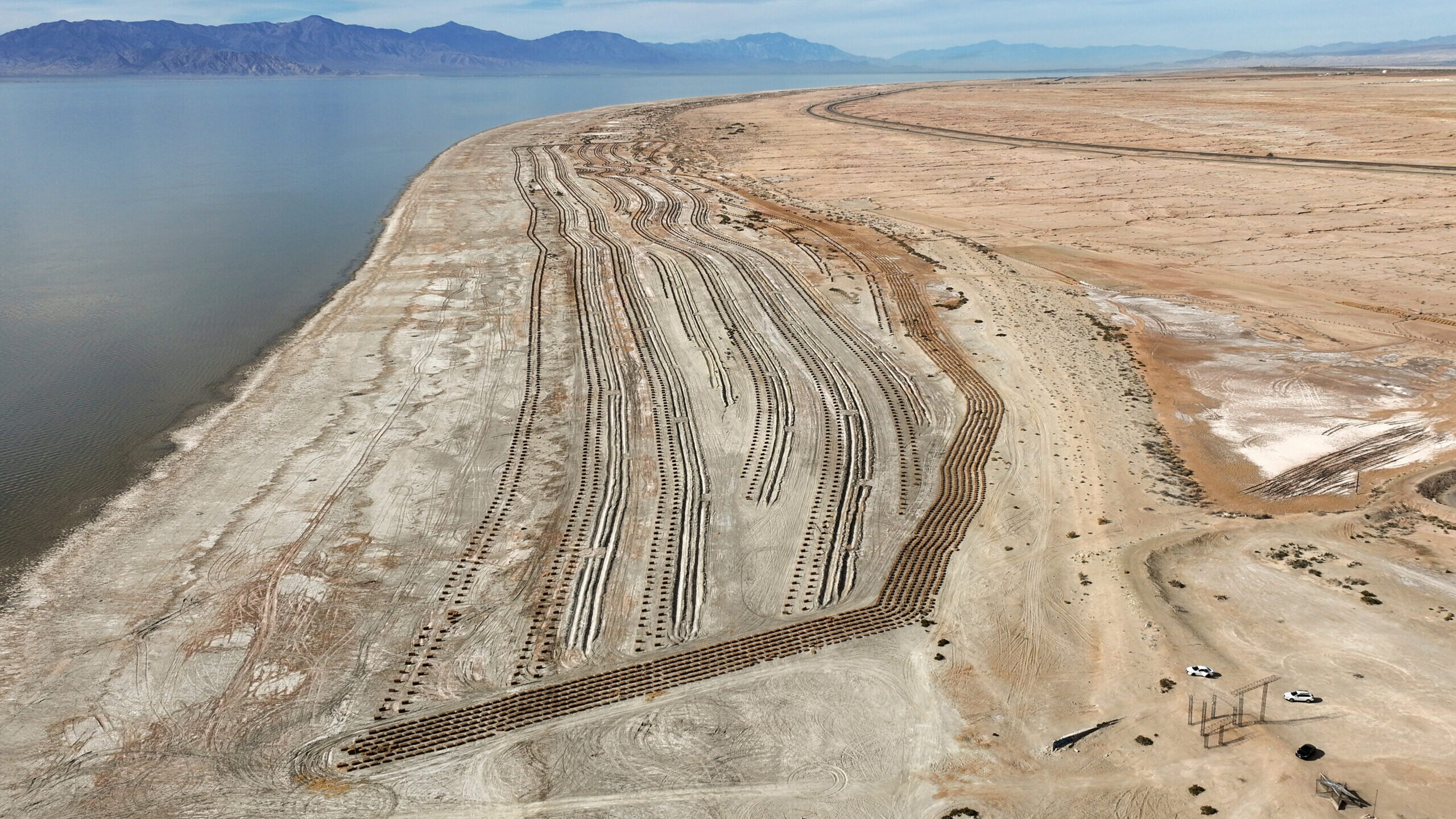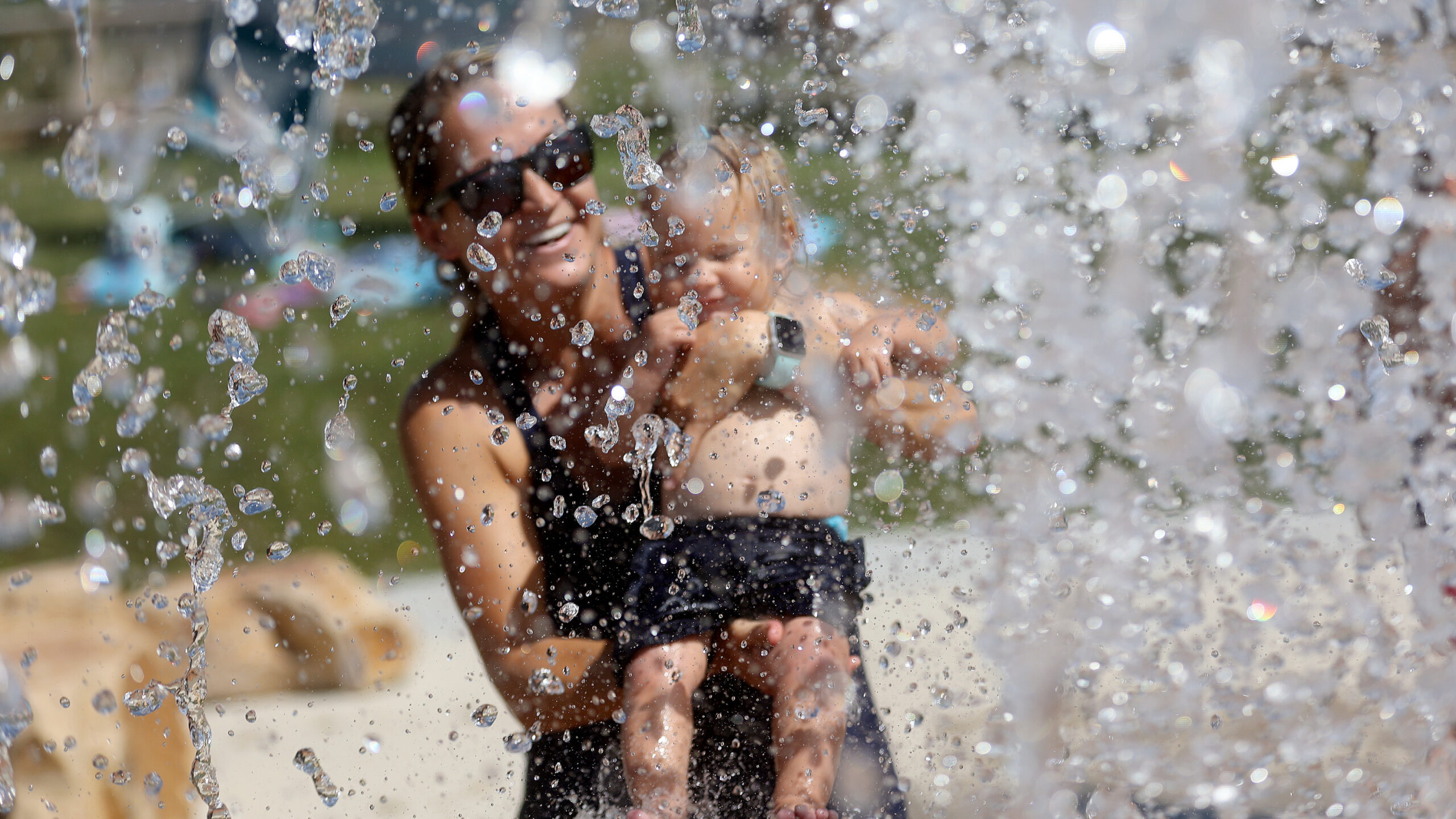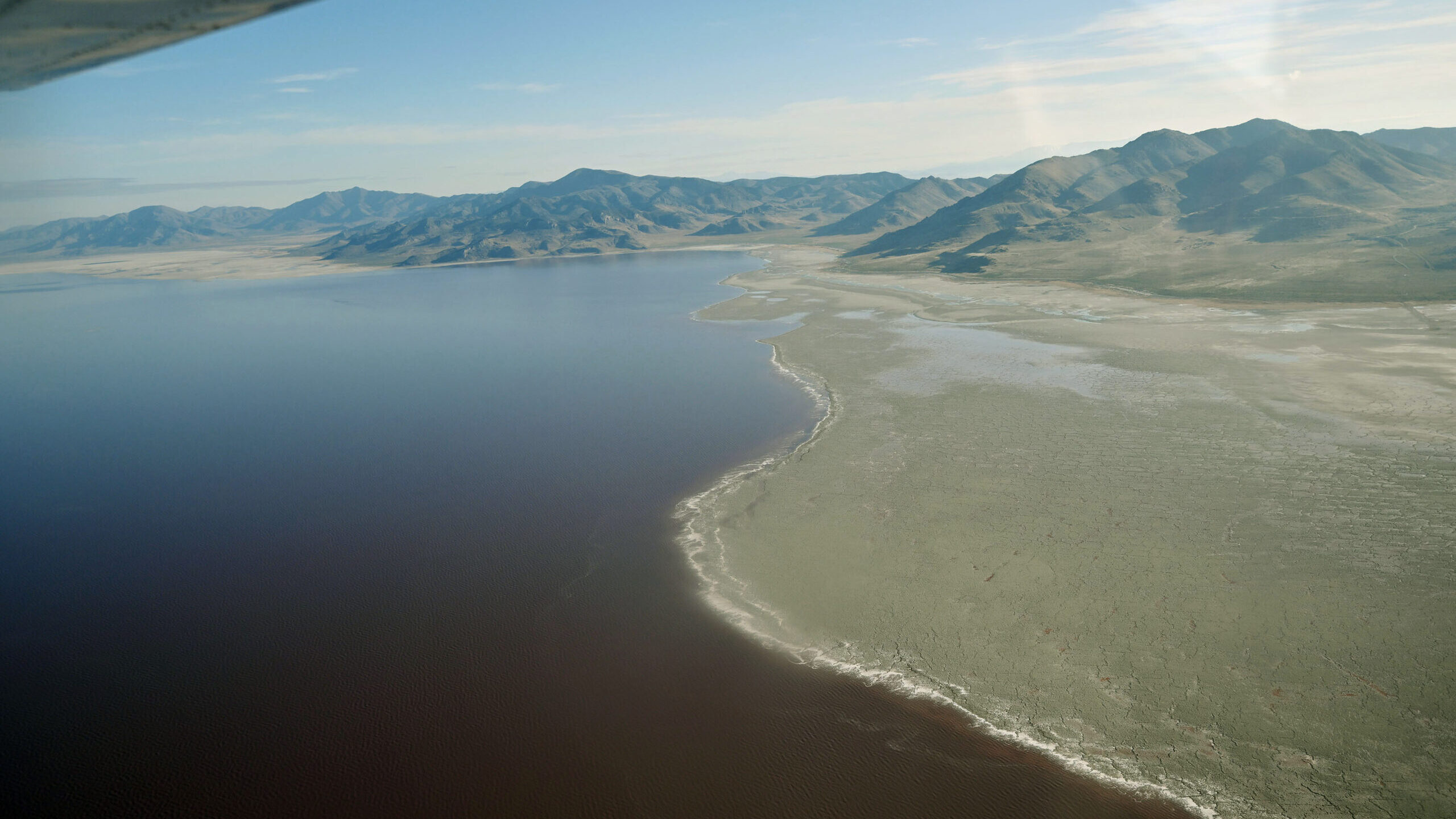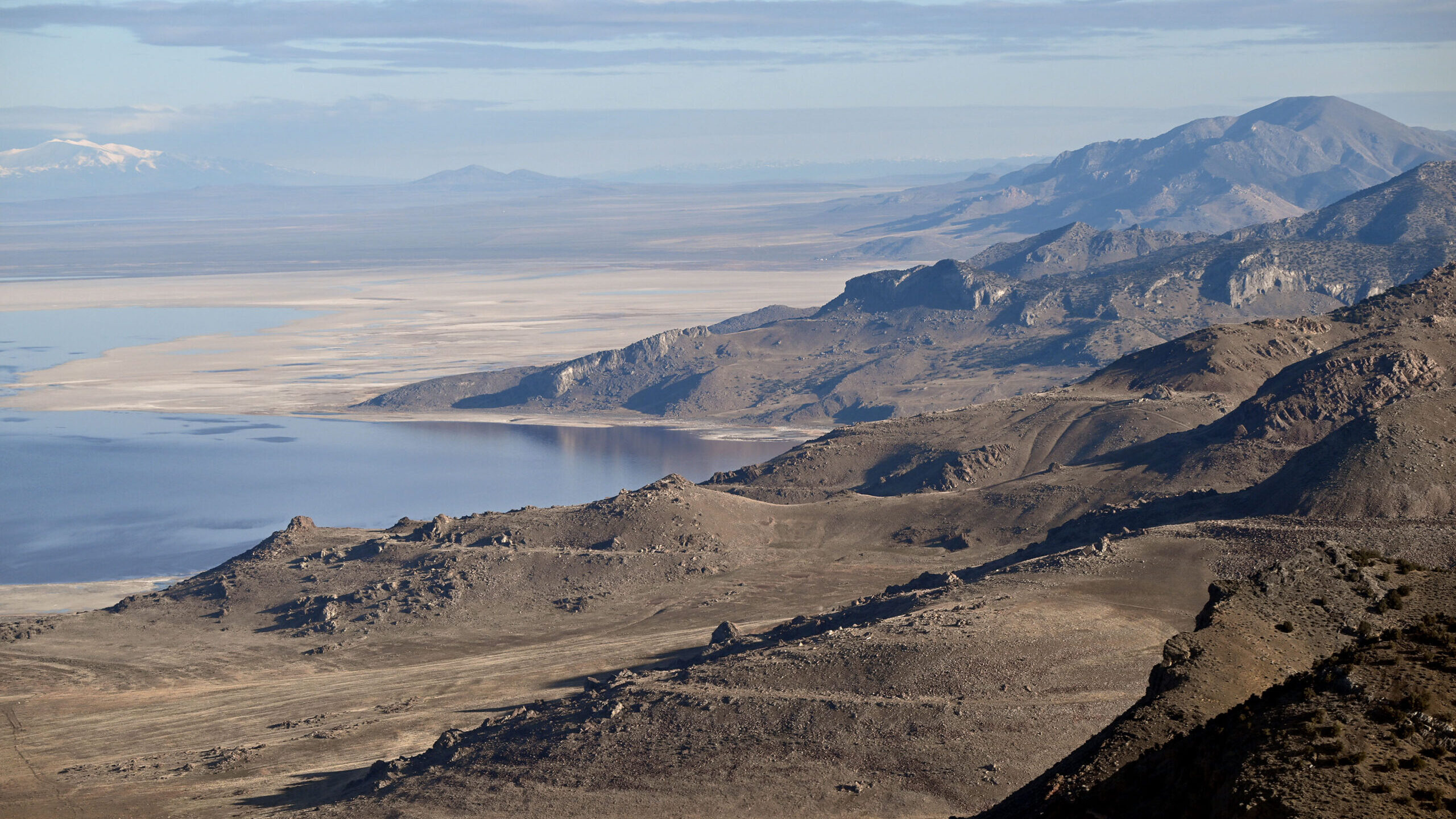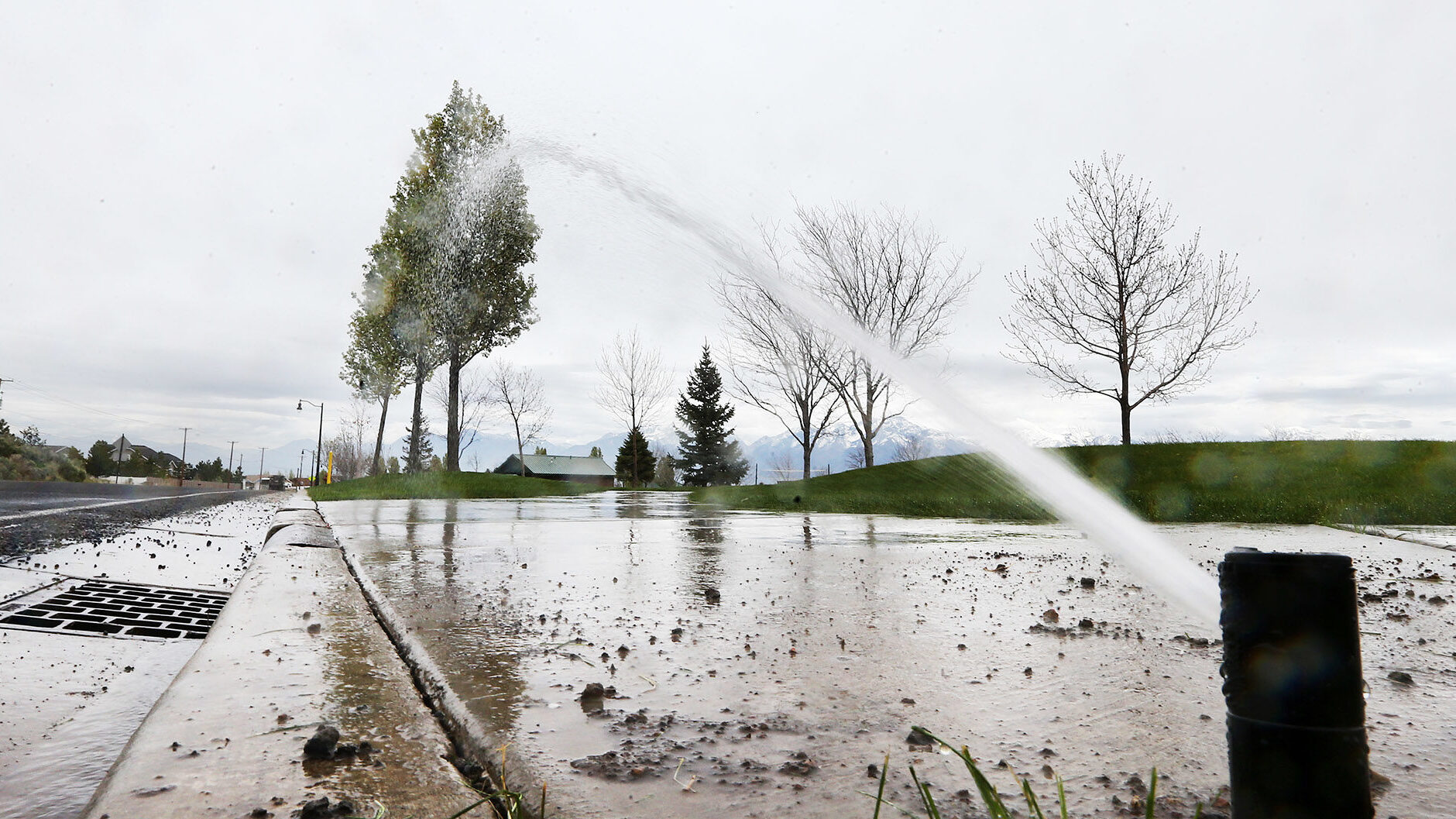Fixing the lake could pave the way to solving Utah’s mental health crisis
Dec 4, 2023, 9:55 AM | Updated: Feb 20, 2024, 10:27 am
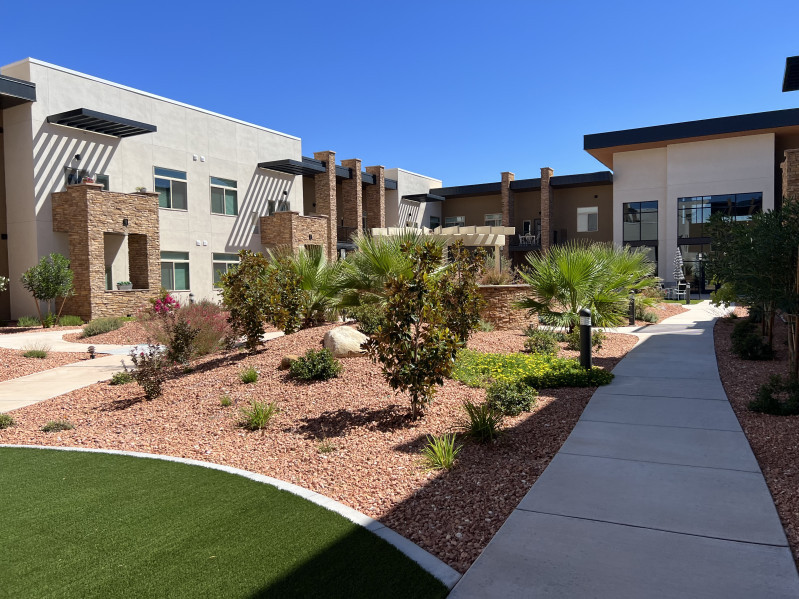
These photos of Legacy Village in St. George, Utah, show zero land dedicated to real grass. It includes some small selected synthetic grass in the courtyards. It was designed by landscape architect Jake Young, who believes in putting grass where people will use it. (Photo courtesy Jake Young)
(Photo courtesy Jake Young)
This article is published through the Great Salt Lake Collaborative, a solutions journalism initiative that partners news, education and media organizations to help inform people about the plight of the Great Salt Lake.
SALT LAKE CITY — Even as a professional landscape architect and city planner, water hasn’t always been top of mind for Jake Young, the principal planner at Citi Design, a land use and planning firm in Farmington. Transportation and essential services? Yes. Zoning and housing? Yes. Water? Not so much — until about five years ago.
“I definitely believed [water conservation] was important all along, but I also think I was in the same frame of mind as others — that the water districts will take care of the water. I would do my job as a city planner and designer, and the water agencies would do their job, and we didn’t need to coordinate,” Young says.
Working on the West General Plan — the Salt Lake County Council’s plan for future growth and development on the Salt Lake Valley’s unincorporated west side — changed that.
As part of the planning process, the county conducted a survey and discovered that local residents ranked water conservation alongside issues such as affordable housing and air quality as top areas of concern. That prompted the planning team to bring the Jordan Valley Water Conservation District into the process.
Incorporating water into his process from the beginning, Young says, made him realize how conservation and city design are inextricably linked. It’s not just that the way we design our cities will determine how much water we use, and how much water is left over to help restore natural assets like the Great Salt Lake. A more holistic approach to urban design may in fact transform our entire life for the better — particularly with respect to our mental health.
Laura Briefer, director of Salt Lake City’s public utilities department, agrees. “I do see that saving the Great Salt Lake creates a much more livable, sustainable city for us all, and I also see that it will be extraordinarily beneficial to our west-side communities.”
THE LANDSCAPE DEFAULT
Connecting the dots between urban planning and water use can be admittedly a bit tricky. After all, the majority of Utah’s water is used by farms, industry and business. And even when we narrow our focus to the water used at our homes, offices and schools, the majority of the water use takes place outside.
Young recalls from his college days, a professor saying grass is just “a drug-dependent rug.” Eliminate the lawns, reduce outdoor water use, and you’re good to go, right?
The reality is not quite so simple, according to Courtney Brown, conservation division manager for the Jordan Valley Water Conservancy District. Yes, it’s true that Utah uses the majority of its municipal water supplies to grow grass. But you have to ask the question — how did all that grass get there in the first place?
When we build a new subdivision or house, Brown says, there’s this whole process with swaths of planners dedicated to the architecture of the structures themselves. Careful attention is paid to the layout of the rooms, the aesthetic design, even the materials and furnishings. In most cases, anything that happens outside the structure itself is an afterthought — one we address by covering everything outside in grass.
“If you look at landscapes that are in high-end neighborhoods, they’re not just all lawn from curb to foundation. They’re planter beds and interesting elements,” Brown says. Lawn isn’t some coveted ideal; it’s a mindless default we install because we haven’t made planning a priority.
That default became particularly entrenched in Utah in 1937, when a church welfare program recommended members plant lawns at their homes and chapels as a beautification project, according to W. Christopher Waddell, first counselor in the Presiding Bishopric of The Church of Jesus Christ of Latter-day Saints. “The appearance of Church and community buildings and homes,” the First Presidency had declared, “mirrors the pride and industry of a people.”
“In more recent years, the impact that caring for these lawns could have on water supplies has become more apparent,” Waddell said in a landmark speech on water conservation in March. He announced plans to incorporate waterwise landscaping at new meetinghouses and temples, including the Salt Lake Temple.
But we don’t all have the financial resources of the LDS Church. And once all those lawns are installed, the added barrier of having to remove a lawn to replace it with water-wise landscaping reduces the odds that a homeowner, property owner or even a city will take that step. That, Young says, is why water conservation must start with city design and planning — requiring water-wise landscapes in new construction is low-hanging fruit.
When you zoom out, these same principles apply to land use planning as well as landscape design, Young says. It is widely understood that housing density decreases per capita water use — potentially allowing more people to live in Utah without increasing the water we take from natural systems and the Great Salt Lake. But you can’t just will this density into existence. Roads, pipelines and public services need to be designed and planned in ways that support urban living. If they aren’t, the default design tends to lead to sprawling suburbs, rising housing costs, and quite possibly, depression.
THE LONELIEST PLACES
Houssam Elokda, community designer, housing expert and managing principal of the design firm Happy Cities, has no direct connection to Utah — he’s based in Canada. But the problems facing the Wasatch Front, he says, aren’t particularly unique. Increasing pollution and environmental collapse. Inequity. Housing shortages and declining mental and physical health.
All of these issues, he says, stem from a single design trend that began after WWII. Car sales had largely stalled in the 1920s, but the car industry funded research that promoted road standards that promoted larger roads and more parking and ultimately created more car-dependent communities. Many of the standards developed then are still in place in many American cities today.
“The communities that resulted from this effort look like this: one area here where people work, a different area where people live, and another area where people shop. The only way to get all those things is to drive, because of the distance between them,” Elokda says.
Since then, a growing body of research has linked social connection and emotional well-being to the community design and walkable communities. “The erosion of walking in our daily life is not just killing our health, it’s killing our social connection too,” Elokda says. “It’s stealing time with families and friends.”
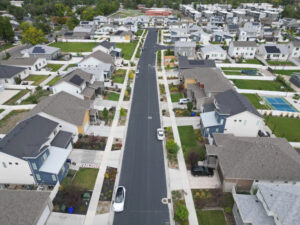
This drone footage shows an entire community built with water-wise landscaping. (Photo courtesy Jake Young.)
Every time you leave your house on foot, Elokda says, it increases the odds you will bump into your neighbor and exchange a friendly greeting. And each of those greetings increases the chances that neighbor will become a trusted friend. Without these daily interactions, our social circles inevitably shrink.
“The two loneliest places are the skyscraper and the suburb,” Young says, citing work by Happy Cities. “You pull into your home, you pull into your garage and you don’t even walk on the sidewalk. You go inside and watch TV.”
Solving this, Young says, requires a holistic approach to planning that replaces the sectioned-off city with more mixed-use development, smaller lots and intentional neighborhood design. You can’t walk to a corner coffee shop or store that doesn’t exist.
And the same principles that apply to urban design coincidentally apply to landscaping as well, Brown says. Water-wise doesn’t mean replacing grass with gravel — it requires planning out specific places for gatherings and play. That, in turn, makes landscapes more functional than the conventional swing-set-atop-a-lawn setup, where the swing set and the automatic sprinklers often interfere with each other.
NATURALLY CONNECTED COMMUNITIES
As with landscaping, it’s far easier to address urban design in new development, Young says. Bringing the Jordan Valley Water Conservation District into the planning process educated him on where the county’s water supply comes from, how it is used, and how various factors, such as housing density, impact water use. If you’re going to make this kind of water-wise development happen, he says, you need to start from the ground up.
A model code called Growing Water Smart is coming to Utah. It suggests evaluating the impact of each development on the water supply, implementing the highest water efficiency standards for toilets and faucets in new development, reducing turf and water use outside and creating water-efficient land use patterns that prioritize high-density development. But it’s not just the zoning and code that needs to change, Young says. Higher density requires fewer, but larger, water pipes to connect urban cores to existing and future sources of water.
Landscaping also factors into the planning equation. The link between wellness and access to green space is well known; wealthy individuals have “moved to the country” to combat chronic health conditions since the dawn of the industrial revolution. This desire for green space — and a sense that the only way to guarantee access to it is to hoard it up in a private yard — has contributed significantly to urban sprawl, according to Elokda. To combat this, public green space must be incorporated into city plans from the beginning.
Public green space can exist on a grand scale — think New York City’s famous Central Park — but it doesn’t have to be that way. It can also take the shape of a small park with a few benches and trees tucked between apartment blocks, Elokda says. Or it could just mean planting and maintaining trees between street lanes or sidewalks. The goal is frequent exposure to green spaces, even in small doses.
It also doesn’t need to look like Central Park. There’s a place for grass and trees, Young says, but he also holds that “if the only time you step on the grass is to mow it, then it probably shouldn’t be grass.” So grassy fields for soccer or baseball — absolutely, those are in. But smaller spaces between buildings should incorporate more native and waterwise vegetation, Young says.
“That waterwise landscape can look like it belongs in the mountains or the foothills. There’s a lot of variation,” Young says. “It can be modern or prairie, mountain or traditional.”
Restoring natural habitat and integrating it with built infrastructure such as water storage and water treatment can come with significant cost savings. Data from the National Park Service have determined, for example, that building seawalls results in five times more maintenance and repair costs than restoring coastal wetlands — and that habitat restoration is more effective at preventing hurricane-related property damage in coastal communities.
Salt Lake City has already embarked on developing an integrated watershed management plan that views drinking water, sewer and stormwater management as part of one larger ecosystem, according to Briefer, with Salt Lake City’s public utilities department. Mountain snowpack feeds the system at the top of the watershed, and the Great Salt Lake receives it at the bottom. Restoring local waterways such as the Jordan River with native vegetation would create habitat, improve water quality, and potentially even attract investment to the west-side communities nearest to the Great Salt Lake, says Briefer.
“We’d have to be deliberate in how we go about that so we don’t have unintentional impacts and to make sure we’re lifting those communities up and not just displacing them,” Briefer says.
Elokda believes integrating infrastructure planning with land-use planning that centers social connection could take this a step further. The cost of roads and pipes to individuals decreases when it’s spread across 1,000 residents instead of 100 residents. Residents could use those savings in other areas of their lives right about now. “The greatest crises facing our cities today — affordability, homelessness and the environment — are all connected,” he says.
TRANSITION PLANNING
In Young’s view, the state is well on its way to addressing the need to address water use in community planning and new development. Senate Bill 110, which passed the state Legislature in 2022, requires municipalities around the state to integrate water use and preservation into their general plan by the end of 2025. But he and other experts agree, it’s not new development that presents the greatest challenge. It’s retrofitting existing properties.
While Utah will have to deal with the effects and costs of urban sprawl for some time, Young does believe we have access to a viable, relatively immediate solution through replacing lawns with smaller dwelling units. And there is ample room to add new dwelling units to existing lots, Young says. In most cities, up to 10% of residential lots accommodate a second unit such as a basement apartment, but in Utah right now the average for most cities hovers between 1 to 5%.
This so-called “missing middle” of housing — twin homes, duplexes and other forms of attached housing — is the density sweet spot that research by Happy Cities and other parties suggests promotes connected communities and social well-being, Young says. They aren’t skyscrapers, nor sprawling subdivisions. It’s the kind of place you might actually get to know your neighbors over a barbecue in your shared backyard.
Shared efforts to improve our communities and reduce our water use could further boost cohesiveness and well-being. Perhaps what we need is not just a Flip Your Strip program, but an official, Flip Your Strip community block party.
For his part, Young says, emphasizing water and holistic planning in his professional practice has helped boost his own happiness as he’s found a sense of purpose and connection in helping the Great Salt Lake, and the people who live around it.
“I’m going to stick with water conservation integrated into everything I do,” he says. “It’s a way of life — a way for a professional to be successful and also feel good about the work that you do.”


